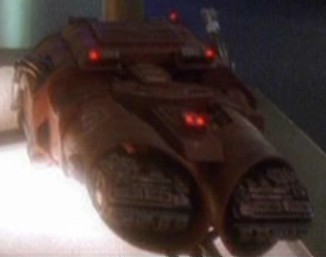Cloaking Device, Hull-Conformal
From betleHWiki
Similar to the Romulan cloaking device, the Klingons received this technology from the Romulans circa 2268, when the two civilizations shared a political alliance.
One of the first Klingon vessels to be equipped with the device was the IKS Klothos, whose Commander, Kor, used it to great effect at the Battle of Caleb IV. The device was soon used aboard many other Klingon vessels.
Continual improvements in the cloaking and detection methods have sparked a certain war of progress. In the early 2360s, the Klingon Empire experimented with interphase cloaking technology but the research was abandoned due to several accidents.
Klingon cloaking devices weigh less than their Romulan counterparts. Although the Klingons received the technology from them, the two races have clearly employed the technology and general ship tactics in very different ways. While many of the Klingon ships are small and nimble, the Romulans prefer to use larger vessels such as the D'Deridex Class, which are both more massive and powerful that most Klingon ships, but also less maneuverable.
Technical Aspects
In order to function, a cloaking device needs to be tied into a ship's deflector shield grid. Along with high power consumption, this is why a cloaking device and a ship's shields cannot be raised at the same time.
Ever since the original encounter with the cloaking device, there has been an ongoing technological race between the galactic powers, as organizations like the Federation try to develop new ways of penetrating the cloak, those who use the cloak continually devise ways to render it impenetrable.
Due to the enormous amount of power required to generate a cloaking field, there is by and large not enough power available to also power the weapons. However, there have been a few times when advances in cloaking technology have allowed a ship to fire while cloaked, like the IKS Kla'Diyus, which had a low-power cloaking device.
Counter Measures
Versions of the cloak used by the Klingons in the late 23rd century had their flaws. Visible energy distortions were detectable while cloaked and prior to decloaking, and in 2293, the Enterprise-A developed a method of using a torpedo to track the plasma exhaust of a cloaked ship.
In the 24th century, the Federation protected its borders from cloaked Romulan incursion by a gravitic sensor net. In 2368, Geordi La Forge developed a technique called the Tachyon Detection Grid that used tachyon beams transmitted between different points to expose cloaked objects. Soon, this had been implemented on the Federation's border outposts as well as in Klingon space.
It is less commonly known that cloaked ships radiate a slight subspace variance at warp speeds. These variances typically vanish once the vessel drops out of warp. If a cloaked ship exceeds its maximum propulsion capacity, it will not be able to fully cloak, and will appear on navigational sensors as a sensor echo.
Using modified cloaks, a combined fleet of Romulan and Cardassian warships attempted to conduct a sneak attack on Founders' homeworld in 2371. They determined that as long as their fleet traveled under the speed of warp 6 their warp signatures would remain undetected, even while under cloak. This modification, however, did not prevent the fleet from being detected by the sensors aboard Deep Space 9. In this case, the cloaked fleet appeared as high concentrations of tetryon particles.
The Dominion, as well as the Cardassians, also possessed many methods of breaking through cloaking fields, including a long-range tachyon scanner and an antiproton beam. However, these methods were not always effective as Thomas Riker was able to partially counteract the antiproton beam scanning method by adjusting the cloak's resonance frequency.

